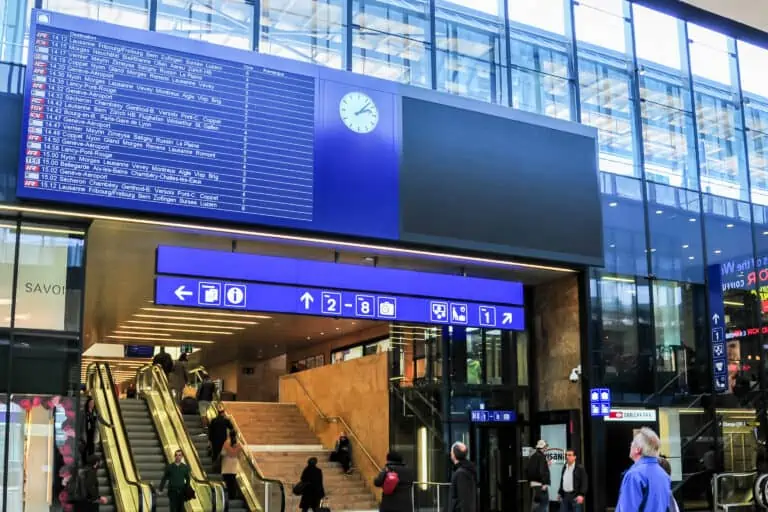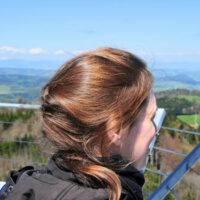The rail network in Switzerland
Switzerland’s extensive train network
Switzerland has a fantastic rail network with rail stations in many towns and villages. Rail stations are usually in the town center. Local attractions can mostly be reached on foot. Details can be found on the map of Switzerland.
Additional buses and other transport modes
Places that cannot be reached by train can be reached by switching to a bus or another mode of public transport. Bus routes complement the rail network: if a route is serviced by trains, it is usually not serviced by buses as well, and vice versa. So you don’t get to choose the mode of transport. You simply use what’s being offered on a particular route.
How to plan your trip
The Swiss timetable shows how to travel from A to B. It shows what time to depart, where to switch if necessary, and what time you will arrive. The timetable knows about nearly all modes of transportation. So if you need a bus or a cable car to reach your destination, it will show that too.
How to choose and buy your ticket or pass
Board with a pass or ticket, without reservations
Traveling by train in Switzerland is easy and does not require lots of planning ahead: you simply buy a ticket for a specific route and day, and just board any train. For special tickets, such as Supersaver tickets, exceptions to this rule may apply.
There is no need to book seats, except for a few international trains and panoramic trains such as the Glacier Express. The timetable will indicate that for such trains.
Find out which ticket or pass you need before buying
Buying point-to-point tickets usually isn’t the cheapest or most convenient way to pay for your trips. Some rail passes allow you to travel by any train, bus or boat on any route, as much as you like. This is often cheaper and a lot easier. There are many rail passes to choose from. How to choose is explained here.
Where to get your ticket or pass
Larger rail stations have a staffed ticket office that sells point to point tickets. All rail stations have ticketing machines. Rail passes can be purchased online and at ticket offices. Find out where you should buy.
Train types and train companies don’t matter
The train type (InterCity, regional train, local train, et cetera) is not important when traveling. The rail company operating the train is not relevant either. You can just travel as the timetable suggests. There are no price variations between train types or railway companies. A ticket or a pass is valid for any train type and any company operating on the route that’s indicated or your ticket or that’s covered by your rail pass.
Exceptions may apply to special tickets, such as the Supersaver ticket, and a few panoramic or international trains.
Regional fare networks
Some regions have a fare network and work with an alternative ticket type: a ticket allows unlimited traveling within a specific area during a certain time frame (for example: two hours). The validity duration is indicated on your ticket. All modes of transport are included. Public transport in Zurich works like that, for example.
You don’t have to worry about this if you have a rail pass that allows free traveling.
How ticket checks are performed
Checks of your train tickets or pass
You don’t have to show anything when boarding. You do so when train personnel comes along during the ride and asks for it. In most cases you can’t buy a ticket on board, so be sure to have a valid ticket or pass before get in. You’re risking a fine if traveling without a valid ticket or pass.
Some trains don’t have personnel on board. In that case, there are mobile teams that board such trains randomly and perform checks.
Take along your passport or ID card
The personnel may ask for your passport or ID card too, to check if you’re the rightful owner of your pass or ticket. This is why you always need to carry your passport when traveling by Swiss public transport. A copy of it is mostly not accepted.
How to find your platform and train
Navigating at small rail stations
Smaller stations only have one or two platforms. Signs indicate which platform your train will depart from.
Navigating at larger rail stations
Large stations have multiple platforms, and sometimes multiple floors. Still, it’s not hard to find your train. If you know the departure time of your train and its destination, you can quickly find it on the large blue displays. The trains are listed there, and so is the platform number. Then just follow the blue signs to that platform.
If you want, you can study maps of the larger Swiss rail stations through the resources provided here.
Finding the right position on the platform
At the platform, there are again displays showing the departure time and destination of the next train. In case of a long train, they also show which section (A, B, C, et cetera) of the platform will be the position for 2nd class and 1st class coaches.
Trains that split up: board in the correct section
In some cases you need to pay a little more attention. There are a few trains that split during their journey. They stop at a station along the way and split in two sections there: one section continues to one town, the other to another town.
An example is the train from Interlaken Ost into the Jungfrau Region. At the rail station of Zweilütschinen, it splits into one part that continues to Grindelwald, and another one that’s headed for Lauterbrunnen.
So you should be seated in the section bound for your destination. If a train has multiple destinations, you will see so at the platform display and in/on the train coaches.
What if the train is delayed
Swiss trains are normally very punctual. Delays can happen though. The displays at the railway station will show the amount of delay and the expected arrival time. In case of significant delays, there are often intercom announcements as well. They’re usually provided in German, but also in English, especially at the larger rail stations.
If you have to change trains and your first train is delayed, your next one may wait for it. If not, you can simply wait for the next one to your destination. Rail passes and regular train tickets are valid all day.
Exceptions:
- If you have a special kind of ticket with restrictions, such as a Supersaver ticket, this is valid for one specific train and departure time only.
- If you’ve made seat reservations, these too are valid for one specific train and departure time only.
In these cases you want to be sure you’ll catch the right train. You can plan your journey with the timetable and avoid tight connections. Even though just a few minutes are usually enough to change trains, you may feel better with some extra margin.
Getting on the train
Sit where you want, unless a seat is reserved
As explained before, seat reservations are very exceptional in Switzerland. You can sit wherever you like, unless the seat is reserved. If that’s the case, it’s indicated by a small display above the seat, or a sign on the seat itself. But you won’t see this often, except for certain international and panoramic trains.
Where to sit with a 2nd and 1st class pass or ticket
If you have a 2nd class ticket or rail pass, then sit in the 2nd class coach as indicated inside the train and on the outside too. You can sit anywhere if you have a 1st class ticket or pass.
Special zones: quiet zones, family zones and bistro sections
Note that some trains have quiet zones (where you’re not supposed to talk, call, or cause other kinds of noise), family zones, and business zones. Some train have restaurant sections too. They’re indicated by clear pictograms. Be sure to sit elsewhere if these zones don’t fit your travel needs.
Getting off the train
The next station will be announced through the train intercom (mostly in multiple languages) and/or the display in the train. Also, there are signs with the station name on the platforms, so you can double-check as the train pulls into the station.
Regardless of whether you travel with a ticket or a pass, you’re allowed to break your trip along the way and continue traveling later that day, unless your ticket indicates otherwise. Again, Supersaver tickets and seat reservations are valid for one specific train and departure time only.
Request stops
Trains usually stop at all stations as indicated in the timetable. However, some trains only stop on request at small stations. In German, this is called “Halt auf Verlangen” (“stop on request”). The timetable shows whether that’s the case, and so do the train intercom and/or displays. You need to press a button near the doors to signal the train driver that you want to get off. Do so a few minutes before arrival.
There’s also a button at such stations. You need to press it to request your train to stop for boarding. Do so no later than two minutes before arrival.
How to behave on board Swiss trains
Train traveling in Switzerland is a great experience, especially if all passengers take each other into account. Your fellow travelers will appreciate it if you stick to a few basic rules:
- When boarding, first give way to the passengers that get off the train. Patiently wait until you can get in.
- If you want to sit down next to a passenger you don’t know, it’s appreciated if you ask if the empty seat is available. If you’re not sure how to do so, making eye contact and pointing to the seat works as well.
- Put your luggage in the designated areas above or between the seats, so that seats are available for passengers.
- You’re allowed to eat and drink. But it’s best not to use products that have a strong odor, that are crumbly, or that cause a lot of noise.
- Please dispose of your waste in the small bins in the train carriage, or in larger bins at the train stations.
- Don’t annoy other passengers with loud conversations, music, or phone calls. If you want to listen to music or watch videos, use a headset and pick a low volume.
- Don’t put your feet on the seats.
Other websites of interest
- www.sbb.ch: quiet zones and family zones in Swiss trains
- www.sbb.ch: fare networks in Switzerland
- www.sbb.ch: information and maps for Swiss rail stations

